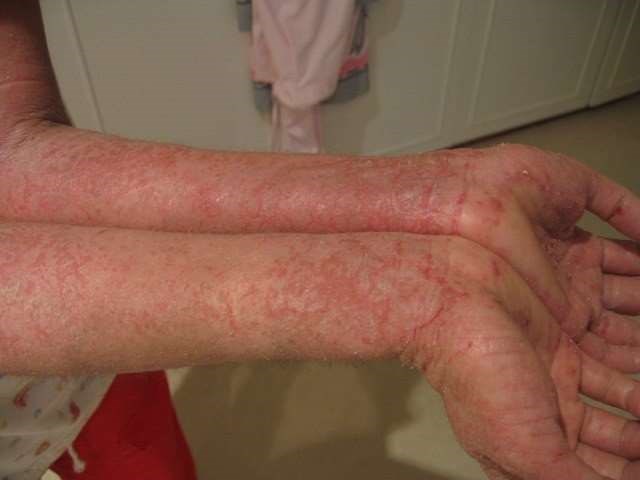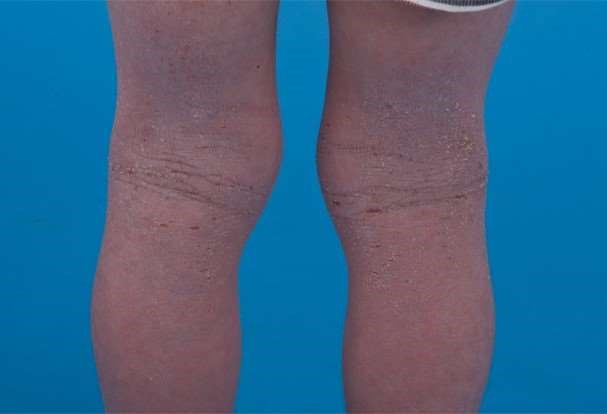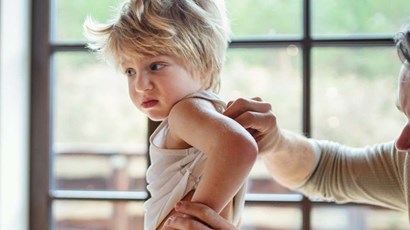Eczema in Children
Most children with eczema have atopic eczema, but some children with eczema have a different condition called contact dermatitis - which is a reaction to a substance on or near the skin. It is not unusual for a child with atopic eczema to also have contact dermatitis to certain products applied to the skin. There are other types of eczema, which are much less common in children.
Atopic eczema (sometimes called atopic dermatitis) is a skin condition that causes inflammation of the skin, which often tends to flare up from time to time. Atopic eczema can be constant and severe for a minority of children. It usually starts in early childhood.
There is no cure for atopic eczema but treatment can usually control or greatly ease the symptoms. Children with eczema have an increased chance of developing other atopic conditions, such as asthma and hay fever.
Contact dermatitis is slightly different to eczema as it is caused by a substance that causes patches of inflammation on the areas of skin which have come into contact with that substance. If that substance can be avoided, the skin inflammation usually disappears.
Some children with atopic eczema may develop contact dermatitis as well. Sometimes the contact dermatitis is caused by a reaction to certain moisturisers (emollients) used to treat atopic eczema.
See also the leaflets on Atopic Eczema and Contact Dermatitis for further information.
What causes eczema in children?
Atopic eczema is thought to be caused by a combination of genetic factors affecting the immune system, and environmental triggers.
Children who have a parent or a brother or sister with atopic eczema are more likely to develop eczema themselves. The environmental triggers are different for each individual child. See below for further information.
Children with atopic eczema often have very dry skin and this dryness may make the skin more likely to react to certain triggers, causing it to become itchy and sore.
What are the symptoms of eczema in children?
Atopic eczema causes areas of itchy skin that are sore, dry and cracked. The severity of eczema can vary a great deal from child to child. There are usually times where the symptoms improve (remissions), and times where the symptoms get worse (eczema flares).
Eczema flares may be only occasional or may occur as often as 2 or 3 times a month. More severe eczema can cause more constant widespread inflamed skin all over the body and itching.
Eczema arms

Jambula at English Wikipedia, Public domain, via Wikimedia Commons
By Jambula at English Wikipedia, Public domain, via Wikimedia Commons
Atopic eczema can occur all over the body, but is most common on the hands, the front of the elbows or backs of the knees, and on the face and scalp.
Eczema

IAID, CC BY 2.0, via Wikimedia Commons
By IAID, CC BY 2.0, via Wikimedia Commons
Eczema typically causes areas of skin to be very dry and itchy. Mild eczema may be only slightly itchy with small areas affected. In more severe eczema, the inflamed skin can become red on lighter skin tones, or can become darker brown, purple or grey on darker skin tones.
Eczema can be more difficult to see on darker skin tones but other signs of eczema such as itching and dryness will help diagnose the condition.
Once improved, the affected skin may also be darker or lighter after. These effects may be more noticeable in darker skin tones. Eventually the skin should return to its normal colour.
The itching, burning and pain from scratching can also disrupt sleep and cause difficulties with everyday activities. In children, this can sometimes be seen as being irritable, upset and sometimes clingy during the day.
It may be difficult to distinguish between areas of skin with atopic eczema and contact dermatitis. The symptoms of contact dermatitis also vary but include dryness, redness, burning or stinging of the skin, and painful blisters may also develop.
Psychological and emotional difficulties
Eczema can cause considerable distress, and can lead to depression.
Preschool children with eczema have higher rates of behaviour problems and dependency on their parents. School children with eczema may have problems such as time away from school, poor school performance, being restricted from social activities, teasing, and bullying.
Eczema can also be associated with poor self-image and low self-confidence.
Sleep disturbance can also be a major problem for children with eczema, and for their families.
What can trigger eczema in children?
There are a number of possible triggers, which are different for each individual child. Common triggers include:
- Skin irritants, such as soaps and detergents (for example, shampoo, shower gels, bubble bath, washing-up liquid).
- Extremes of temperature, dampness, humidity.
- Inhaled triggers, for example, house dust mites, pet fur, pollen and moulds.
- Food allergies, for example, cows' milk, eggs, peanuts, soya or wheat.
- Skin infections.
Infected eczema
Occasionally, areas of skin affected by atopic eczema can become infected. Itching and scratching can cause bleeding from open wounds or scratch marks, increasing the risk of infection. Signs of an infection can include:
- Eczema getting worse.
- Fluid oozing from the skin.
- Yellow crusts or small yellowish-white spots appearing in the eczema.
- The skin becoming swollen and sore.
- Child becoming hot and shivery and generally feeling unwell.
See a healthcare professional as soon as possible if you think your child's skin may have become infected.
Occasionally infection with herpes simplex virus (cold sores) can occur. If this spreads it can lead to a condition called eczema herpeticum, which is a medical emergency and needs immediate medical attention.
How to treat eczema in children
There is no cure for eczema but treatments for atopic eczema can help to ease the symptoms. The treatments needed generally depend on the severity of eczema. The main treatments for atopic eczema are:
- Emollients (moisturisers), which must be used every day and help to stop the skin becoming dry.
- Topical steroid creams or ointments, which reduce swelling and redness when the skin becomes red and inflamed.
The main treatments for contact dermatitis are similar in terms of using emollients and topical steroids, but the main treatment is to identify and avoid the cause of the contact dermatitis.
Neither skin barrier creams or petroleum jelly are recommended for the usual treatment of atopic eczema or contact dermatitis.
Emollients
Emollients are moisturising treatments applied directly to the skin. They help to make the skin feel less dry and may also help reduce the number of eczema flares. Several different emollients are available.
You may need to try a few to find the one that works best for your child. A particular emollient that has been used for some time may start to become less effective and irritate, and so alternative emollients will then need to be tried. Talk to a pharmacist for advice on which emollient to use.
You should use the emollient all the time, even when eczema is not causing any symptoms. During an eczema flare, apply the emollient more frequently, as well as using other treatments, such as a short course of a topical corticosteroid (see below).
Do not put your fingers into an emollient pot but use a spoon or pump dispenser instead, as this reduces the risk of infection. Never share the emollient with anyone else.
Topical corticosteroids
If the skin becomes sore and inflamed, a topical steroid can reduce the inflammation. There are different strengths of topical steroid and the one that should be used will depend on the severity of the eczema and the areas of skin affected.
Your pharmacist or doctor can advise which steroid creams work for where it is in on the body. As a rule- steroid creams should never be used on the face unless prescribed by a doctor.
Self help
There are things you can do to help ease eczema symptoms:
Avoid or reduce scratching:
- Gently rubbing the skin with your fingers may help to relieve itching without causing the skin damage associated with scratching.
- For babies, anti-scratch mittens may stop them scratching their skin. Keep nails short and clean to reduce any damage from scratching.
- Keep the skin covered with light clothing.
Avoiding triggers: it can be difficult to identify specific eczema triggers but there may be ways to reduce any bad effects caused by triggers that can be identified, such as:
- Avoid wearing any fabrics that seem to irritate, and keep to natural materials such as cotton.
- Keep rooms cool if heat seems to be a problem.
- Avoid soaps or detergents that may affect the skin. Use soap substitutes instead.
Although house dust mites may be a problem, trying to rid your home of them is not recommended as it can be difficult and there's no clear evidence that it helps.
Some foods, such as eggs and cows' milk, can trigger eczema symptoms. You should not make any significant changes to your child's diet, or restricting your own diet if breastfeeding, without professional advice.
You may be referred to a specialist in food and nutrition (dietitian), who can help you to make any required dietary changes without any restriction of the nutrients your child needs.
Other treatments
Other treatments that may be used to help ease eczema symptoms:
- Topical pimecrolimus or tacrolimus for eczema in sensitive sites not responding to simpler treatment. These are prescribed by your doctor or dermatology specialist if needed
- Antihistamines for severe itching. If itching causes sleep disturbance then a sedating antihistamine may be best. Otherwise a non-sedating antihistamine may be preferable because sedating antihistamines can cause drowsiness into the following day, even when given just before bedtime. Your doctor will advise if this is suitable for your child.
- Medicated bandages or wet wraps can be used to cover areas of skin affected by eczema to help the skin to heal.
- More powerful treatments offered by a dermatologist (skin specialist), including more powerful medicines (which also may have more side effects) and phototherapy.
Seeing a specialist
Your child may be referred to a skin specialist (dermatologist) if:
- The diagnosis is uncertain.
- Emollients and short courses of topical steroids are not providing adequate control of the eczema.
- The eczema is causing severe problems with everyday activities or sleep.
A dermatologist may be able to offer further assessments, such as allergy testing as well as discussing other treatments that may be appropriate.
Complementary therapies
Some people may find complementary therapies such as herbal remedies helpful in treating eczema, but there is no evidence to show that these treatments are effective. If you're thinking about using a complementary therapy, speak to a healthcare professional first.
Do children outgrow eczema?
For most children, eczema improves as they get older. One large review found that for 8 in 10 children with eczema, symptoms had resolved by 8 years of age and less than 1 in 20 persisted by 20 years after eczema had been diagnosed.
Further reading and references
Atopic eczema in under 12s: diagnosis and management; NICE Clinical Guideline (December 2007 - last updated June 2023)
Eczema - atopic; NICE CKS, April 2023 (UK access only)
Dermatitis - contact; NICE CKS, July 2018 (UK access only)
Eczema: Atopic Eczema; Primary Care Dermatology Society (PCDS)
Eczema: contact allergic dermatitis; Primary Care Dermatology Society.
